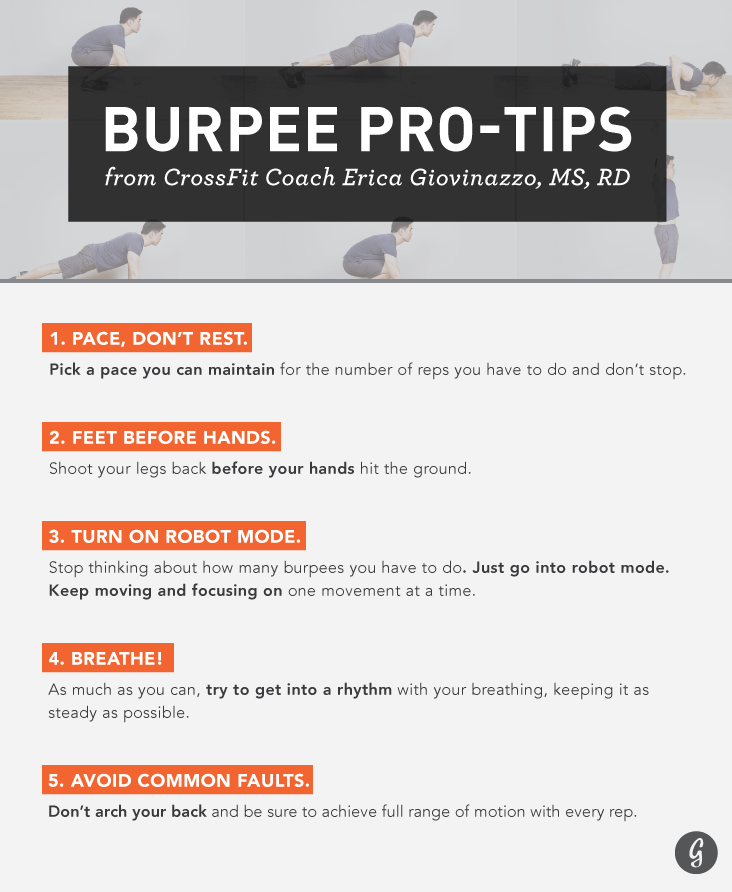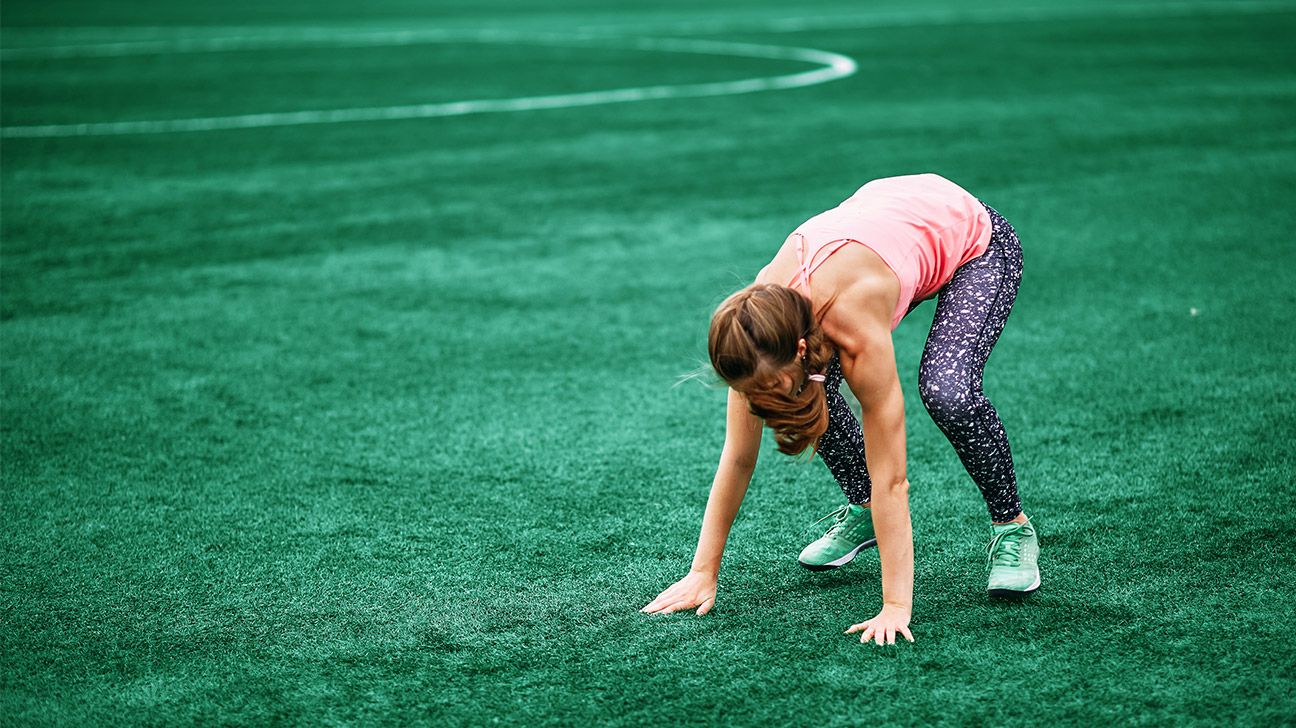The burpee is up there with other love-to-hate health habits, like bitter kale smoothies, sour shots of diluted apple cider vinegar, and why-didn’t-I-bring-a-towel hot yoga.
We may not look forward to it. In fact, in the moment, we swear we’ll never do this again. But as soon as it’s all over, we think, “Oh, ok. That wasn’t half bad. I kinda feel like a badass.” And, of course, we’ll be back at it tomorrow.
The burpee has been around since 1939, when Royal H. Burpee invented this bodyweight movement. (Um, can we just talk about that super awesome name for a second?)
The burpee was used as a quick, simple way of administering a fitness test. Over the last 75 years, the burpee has evolved from its original incarnation as a four-count movement to be performed four times in a row.
The current version of a burpee is now a six-count movement that includes three jumps, a couple of squats, a push-up, and a not-insignificant amount of torment.
It’s difficult to think of another bodyweight movement as demanding as the burpee. The burpee calls on just about every major muscle group, so every part of you is working darn hard to bang out just one rep.
Plus, as CrossFit athlete Eugene Babenko explains, “Twenty burpees equates to more than 20 air squats, 20 push-ups, and 20 jumping jacks,” taking “the body through a very full range of motion requiring a lot of oxygen in a short period of time.”
In other words, doing just one burpee requires a ton of movement and places huge demands on the burpee-doer’s cardiovascular fitness.
CrossFit coach and nutritionist Erica Giovinazzo, MS, RD, says burpees make such a good conditioning tool because they not only require use of the whole body but also take the exerciser through multiple planes:
“If I were to run, or row, or even do something like jumping jacks or jump rope, I’m pretty much staying in one spot or just moving straight ahead. A burpee makes you go up and down and up and down. This increases the heart rate dramatically,”
This also might explain why there are so many anecdotal reports about the miseries of burpees. There’s no doubt burpees are intense — and that’s a good thing.
Studies have shown that when it comes to exercise, intensity matters. The more intense the movement, the greater the post-exercise elevation in metabolism
Now that we’ve promised you the conditioning tool to end all conditioning tools, it’s time to get to it. No more procrastinating — let’s get down to burpees.
As Babenko notes, the burpee is “a great way to loosen up on its own,” so the best pre-burpee warmup might be just… doing a few burpees.
But if your workouts feel better when your body is ready for what’s coming at it, you may want to do a few specific movements to get warm and ready for burpeepalooza.
Babenko likes animal drills to open tight joints, including scorpion, cobra, bear crawl, and crab walk. Giovinazzo says that before doing burpees, she likes to warm up her hip flexors, feet, rear deltoids, and wrists.
In addition to whatever pre-workout warmup you’re doing, try mountain climbers for your hip flexors. She also recommends rolling a lacrosse ball on your back and rolling the bottoms of your feet with a ball or a barbell.
Finally, stretching the wrists will keep them nice and loose. Giovinazzo says these are all great drills for before and after burpee-centric workouts.
Burpees come in all kinds of variations. Some coaches or gyms may require a push-up, while others won’t mind if you modify the movement by skipping the push-up. You can also walk your feet forward and backward one by one rather than jumping them up and back.
That said, here are the six movements of the burpee as it is most commonly done:
1. Squat
From standing, squat and place hands on the floor in front of you, just outside of feet.
2. Plank
Jump both feet back so you’re in plank position.
3. Push-up
Drop to a push-up — your chest should touch the floor. You can also place your knees on the floor here, which makes the push-up easier.
4. Plank
Return to plank position. This can be a strict push-up, a push-up from the knees, or not a push-up at all. As in, just push yourself up from the floor as you would if you weren’t working out — your choice.
5. Squat
Jump feet back in toward hands.
6. Jump
Explosively jump into the air, reaching arms straight overhead.

So now you know how to do a single burpee. But where does that leave you in a workout that requires several reps in a row? Or 100? Or — gasp — a mile of them?
Take it from Giovinazzo, who does plenty of burpees and programs them for her athletes. Here are her favorite tips for getting through a burpee-heavy workout, in her own words.
Don’t rest — pace
If you stop in the middle of your reps, it only takes longer to get going again. Most people need to stop because they’re going too fast, but the best thing you can do if you’re doing a lot of repetitions is to go slow and steady.
Pick a pace you can maintain for however many burpees you need to do, and don’t stop. So if you only have to do 5 to 10 burpees, you can go a little faster. But if you’re doing 50 burpees, go slower so you can maintain a consistent pace.
Feet go before hands
If you want to take a second off your burpee, shoot your legs back before your hands hit the ground.
When most of us first learn a burpee, we usually learn that our hands should hit the ground before we jump our feet back. But once you understand that basic movement, you can shoot your feet back before your hands land on the ground.
Turn on robot mode
When you have a lot of burpees to do, stop thinking about how many burpees you have to do. Just go into robot mode.
Approach each small movement one at a time: “drop to the floor,” “feet back,” “jump up,” and repeat. Slip into autopilot and keep counting.
Thinking ahead too much gets you freaked out about how many you have left to do. Just keep moving and focusing on one movement at a time.
Breathe
As much as you can, try to get into a rhythm with your breathing. Experiment with what works for you.
Recognize that as you get more out of breath, your rhythm will change slightly. But always try to keep your breathing as steady as possible.
Avoid common faults
Many people fall prey to two faults. The first is arching the back to come out of the burpee, as if they were doing an Upward-Facing Dog pose. This can lead to an aching lower back.
The second fault is losing range of motion. The chest should touch the floor, not just the belly button or pelvis. The hips need to open up all the way at the top when you jump.
Try looking straight ahead as you stand up and jump — this can help you to remember to open your hips.
Maintain good form
One last note: When burpees are being performed for time (as in, doing as many of them as quickly as possible), the perfection of each movement may fall by the wayside as the burpee-er tries to make it through their workout.
And that’s OK — as long as you maintain proper form and a full range of motion. As you bang out reps, each burpee is going to look more like a fluid set of flops and jumps and less like the six crisp, separate movements enumerated above.
That said, if you can’t perform a full burpee as prescribed, consider modifying the movement to make it less taxing. If you have challenges to mobility or are new to working out or burpees, start with a modified version.

There’s nothing more beautiful than the idea of a burpee: a single bodyweight exercise that works tons of muscles while challenging your cardiovascular fitness.
Of course, once you find yourself flopping down, pushing up, and jumping explosively over and over, there’s less beauty and more… sweat.
Nevertheless, the burpee remains an amazingly effective (if punishing) movement and requires nothing more than your body weight and a little space.
Once you master the basics, consider moving on to some more challenging variations like the burpee broad jump or even the burpee pull-up.
Hilary I. Lebow is a health journalist with fitness and nutrition certifications through the Yoga Alliance and the National Academy of Sports Medicine (NASM). When she’s not working, you’ll find her playing on the beach with her two dogs or exploring around Miami, the beautiful city she calls home. Read more of her work here.


